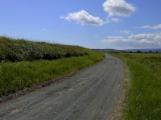17
This photo shows what a modern dyke looks like.15 September 2003
Shepody Marsh, New Brunswick, Canada

18
Once in place, a dyke could reclaim large tracts of very fertile land. In two or three years the salt was, for the most part, washed out of the soil and very nutritious pasture was produced for sheep and cattle. Today we see very few sheep, but cattle can still be seen in many areas, enjoying the luxurious green grasses of the salt marsh.There is a centuries old industry in the harvesting and selling of marsh hay in this area, and there is nothing so pleasant as to sit on a late summer day, watching the farm workers harvesting hay down on the marshes of Albert County or watching the cattle grazing lazily on the marsh grass.